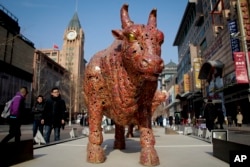The United States says talks in Beijing on ending a bruising trade war focused on Chinese promises to buy more American goods. But it gave no indication of progress on resolving disputes over Beijing’s technology ambitions and other thorny issues.
China’s Ministry of Commerce said Thursday the two sides would “maintain close contact.” But neither side gave any indication of the next step during their 90-day cease-fire in a tariff fight that threatens to chill global economic growth.
That uncertainty left Asian stock markets mixed Thursday. Share prices had risen Wednesday after President Donald Trump fueled optimism on Twitter about possible progress.
The U.S. Trade Representative, which leads the American side of the talks, said negotiators focused on China’s pledge to buy a “substantial amount” of agricultural, energy, manufactured goods and other products and services.
No signs of progress
However, the USTR statement emphasized American insistence on “structural changes” in Chinese technology policy, market access, protection of foreign patents and copyrights and cybertheft of trade secrets. It gave no sign of progress in those areas.
Trump hiked tariffs on $250 billion of Chinese goods over complaints Beijing steals or pressures companies to hand over technology.
Washington also wants changes in an array of areas including the ruling Communist Party’s initiatives for government-led creation of global competitors in robotics, artificial intelligence and other industries.
American leaders worry those plans might erode U.S. industrial leadership, but Chinese leaders see them as a path to prosperity and global influence and are reluctant to abandon them.
The two sides might be moving toward a “narrow agreement,” but “U.S. trade hawks” want to “limit the scope of that agreement and keep the pressure up on Beijing,” said Eurasia Group analysts of Michael Hirson, Jeffrey Wright and Paul Triolo in a report.
“The risk of talks breaking down remains significant,” they wrote.
White House optimism
On Wednesday, White House press secretary Sarah Sanders expressed optimism to Fox Business Network. She said the timing was unclear but the two sides “are moving towards a more balanced and reciprocal trade agreement with China.”
The U.S. statement said negotiations dealt with the need for “ongoing verification and effective enforcement.” That reflects American frustration that the Chinese have failed to live up to past commitments.
Beijing has tried to defuse pressure from Washington and other trading partners over industrial policy promising to buy more imports and open its industries wider to foreign competitors.
Trump has complained repeatedly about the U.S. trade deficit with China, which last year likely exceeded the 2017 gap of $336 billion.
Enthusiasm wears thin
U.S. stocks surged Wednesday on optimism higher-level U.S. and Chinese officials might meet.
That enthusiasm was wearing thin Thursday. Hong Kong’s Hang Seng index fell 0.5 percent while Tokyo’s Nikkei 225 dropped 1.4 percent.
Economists say the 90-day window is too short to resolve all the conflicts between the biggest and second-biggest global economies.
“We can confidently say that enough progress was made that the discussions will continue at a higher level,” said Craig Allen, president of the U.S.-China Business Council. “That is very positive.”
Chinese exports to the U.S. have held up despite tariff increases, partly because of exporters rushing to fill orders before more increases hit. Forecasters expect American orders to slump this year.
China has imposed penalties on $110 billion of American goods, slowing customs clearance for U.S. companies and suspending issuing licenses in finance and other businesses.
U.S. companies also want action on Chinese policies they complain improperly favor local companies. Those include subsidies and other favors for high-tech and state-owned industry, rules on technology licensing and preferential treatment of domestic suppliers in government procurement.
For its part, Beijing is unhappy with U.S. export and investment curbs, such as controls on “dual use” technology with possible military applications. They say China’s companies are treated unfairly in national security reviews of proposed corporate acquisitions, though almost all deals are approved unchanged.
This week’s talks went ahead despite tension over the arrest of a Chinese tech executive in Canada on U.S. charges related to possible violations of trade sanctions against Iran.














